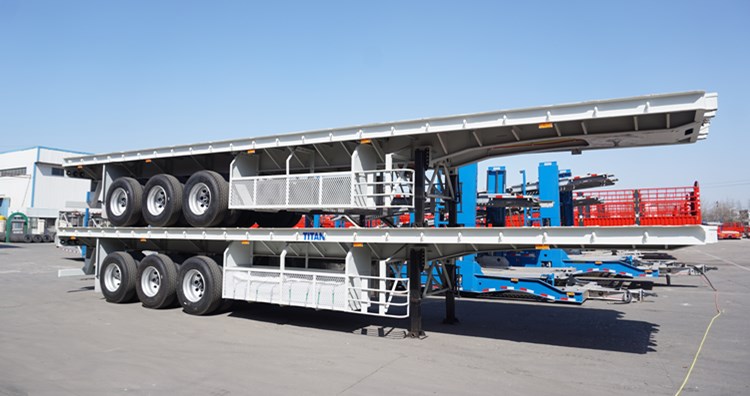Flatbed trailers are usually used to transport 20-foot or 40-foot containers, and are mainly used to support container transportation for ships, ports, waterways, highways, transfer stations, bridges, tunnels and multimodal transportation. A flatbed trailer is a type of trailer whose design is suitable for transporting bulk cargo and containers. Most customers use container transportation, which has lower transportation cost and shorter transportation time. TITAN flatbed trailers can be customized according to the different requirements of customers in different countries/regions.

40 Foot Flatbed Trailer for Sale in Nigeria
1. Check before you start
1-1. Whether the tire pressure of the truck head and semi trailer is the predetermined value.
1-2. The air pressure of the spare tire, whether it is correctly installed on the spare tire frame and whether the nut is locked.
Start the engine and observe the barometer in the cab.
1-3. Press the tractor's handbrake, you will hear an obvious sound of rapid deflation, see the brake cylinder push rod retract, and then release the parking brake.
1-4. Check whether there is air leakage in the air circuit and whether the brake system is working normally.
1-5. Check whether the gas lamp is working normally and whether the electrical connection is good.

2. Starting
After confirming that all inspections are normal, continue to increase the pressure of the brake system, and then start smoothly according to the operating requirements of the forklift head, and check whether the braking of the entire vehicle is reliable.
3. Driving
3-1. Prevent the semi suspension brake system from being used for a long time, avoid the brake system pressure from being too low, and avoid the emergency relay valve from automatically braking the wheels. There is an automatic brake lock.
3-2. To prevent the brake drum from overheating on long or steep slopes, please use the forklift engine brake device to brake as much as possible.
3-3. Pay attention to the height limit signs on the road to avoid collision with the equipment on the road.
4. Separate the overhead semi-trailer from the truck head
4-1. Try to choose a flat and flat ground to separate the semi trailer from the truck head. If the foundation is soft or the asphalt road is to be separated in summer, a thick plank should be placed at the bottom of the lifting feet to prevent reconnection due to sinking loads.
4-2. Operate the lifting foot so that the bottom of the lifting foot is on the ground, then shift to a low speed gear and lift the semi trailer, leaving a certain distance away from the forklift head.
4-3. Unplug the plug from the wire connection socket of the flatbed semi trailer.
4-4. Turn off the overhead trailer air connection disconnect switch on the truck head, and then change the low speed position to remove the tractor air connector from the semi-trailer.
4-5. Pull out the traction seat to unlock the lever, thereby opening the locking block.
4-6. Slowly push the tractor forward to disengage the traction pin from the traction seat to separate the semi trailer and the tractor.
4-7. After separation, check whether all parts of the semi-trailer are abnormal, and then loosen the drain valve at the bottom of the cylinder to drain the water in the cylinder.
5. Loading the container
Before loading the high bed semi trailer into the container, the used rotary lock head should be completely overlapped with the lock base and fixed. Then place the container correctly on the semi-automatic tray

1. In order to connect the traction pin and the traction seat smoothly, the semi-trailer should be in a ventilated state.
2. Raise the cantilever bracket so that the semi trailer tow pin seat plate is about 10-13 mm lower than the center of the truck tow seat. Otherwise, sometimes not only can not connect, but also damage the traction seat, traction pin and related parts.
3. Open the unlock lever of the traction seat on the forklift, and then open the traction locking mechanism.
4. Rotate the forklift backwards so that the flatbed semi trailer traction pin is guided into the opening of the locking mechanism through the V-shaped opening of the traction seat, and then push the locking block to rotate and lock the traction pin.

When reversing, the center line of the truck head and the semi-trailer should be the same. Generally, the offset between two centerlines is limited to less than 40mm. The angle between the two centerlines is limited to 5° at full load and 7° at no load.
5. Connect the gas circuit (connect the truck's gas supply pipe joint to the semi trailer's gas supply pipe joint, and connect the truck's control pipe joint to the semi-trailer's control pipe joint), turn on the semi-trailer connection disconnect switch on the truck head , So that the trailer can get enough air pressure.
6. Connect the circuit, and then insert the wire connection plug of the forklift head into the wire socket of the semi-trailer.
7. Operate the lifting foot correctly to retract it, then pull down the handle and hang it on the hook.
Through the video below, you can learn about different types of flatbed semi trailers (like 3 axle flatbed semi trailer, 4 axle flatbed semi trailer, flatbed semi trailer, container flatbed trailer)
And the process, testing, packaging and customer feedback, etc.
Welcome to click “Technical“, you can get more article about our trailers.
Click “Product“, you can find your favorite semi trailer.